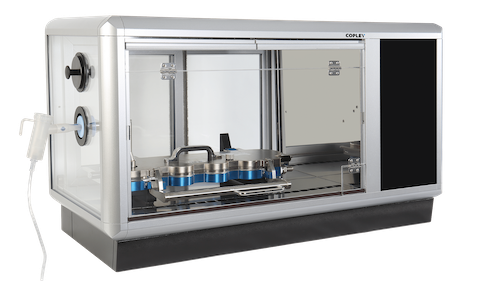In the case of nebulizer testing, simply controlling the temperature of the impactor can be an important step. The Next Generation Impactor (NGI), which is used for compendial testing, must be cooled to 5oC due to its large thermal mass. This approach may also be applicable to aqueous droplet (soft mist) inhalers and some solution MDIs, too. Commercial chambers for controlling the temperature around the NGI are available, a solution that can reduce variability while avoiding the expense of temperature control for the entire lab.
Commercial chambers that control RH as well as the temperature of the testing environment are also available. These chambers vary with respect to size and design of space, and by extension suitability for inhaler testing, and the use of refrigerants and/or desiccants can substantially increase maintenance and running costs, as well as environmental impact. When using these types of chambers, it is advisable to locate heat-generating ancillary equipment such as vacuum pumps outside the controlled environment for optimal efficiency.
For controlling electrostatics, the solution is more often multifaceted. Beyond RH control, appropriate grounding is necessary to mitigate the risk to equipment and operators. Proper selection of clothing, stools, benches, and floor coverings can help to deal with electrostatic problems; in particular, the materials that gloves are made of and how often they are used are frequently key sources of trouble. Electrostatic eliminators such as ionizing air blowers can be effective for generalized electrostatic reduction, but it’s worth highlighting that more advanced environmental chambers have integrated anti-static systems, which can be an efficient way to minimize problems.
Rigorous risk assessment, appropriate training and judicious equipment choice are crucial, especially for sensitive products. We recently conducted in-house studies of electrostatic build up during entire contents DDU testing for a 200 shot pMDI. It was fascinating to see shot weight progressively drift as charge accumulated and, in some cases, weighing scales timed out due to a failure to settle, but a simple anti-static device fixed the problem.
Any last words of advice?
Firstly, don’t underestimate the potential for variability from changes in the test environment; routinely encountered changes in temperature and RH can lead to a meaningful erosion of data quality.
Although the associated mechanisms for such variability may be complex, the solutions are usually simple, though they may require some investment. In the area of test environment control there are relatively quick and easy wins to be made. Recognize the sensitivities of your specific OIP, scrutinize test methods with care, and take appropriate control.
Mark Copley is a leading authority in testing methods and systems for MDIs, DPIs, nebulizers and nasal sprays; authoring and contributing to more than 50 published articles. An invited member of the European Pharmaceutical Aerosol Group impactor sub-team, he has also made recommendations to the Inhalanda working group, leading to subsequent revisions to Ph.Eur. and USP monographs. As part of Copley Scientific’s associate membership of the International Pharmaceutical Aerosol Consortium on Regulation & Science (IPAC-RS), he participates in a number of working groups with a view to enhancing the regulatory science of orally inhaled and nasal drug products (OINDPs).



